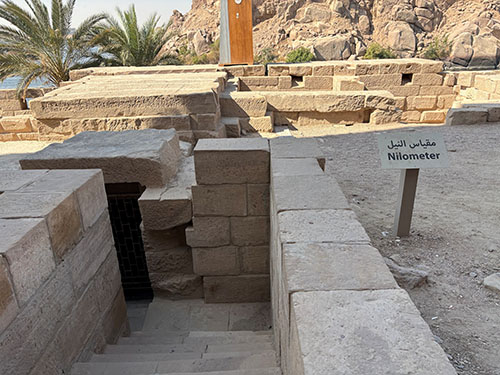Nilometer: A Key Water Guage in Egypt

TAXING FARMERS BASED ON WATER AVAILABILITY
Attorney Laura Schroeder recently returned from Egypt. She shares in this article the use of nilometers in ancient Egypt that offers a fascinating intersection of law, administration, and environmental science. These devices were pivotal in determining tax rates based on the annual flooding of the Nile River, highlighting the sophisticated legal and administrative systems of one of history’s most enduring civilizations.
Nilometers remained in use from the pharaonic period until the Aswan High Dam rendered them obsolete in the 1960s

Legal Framework and Taxation
In ancient Egypt, taxation was deeply tied to the Nile’s water levels, as measured by nilometers. These structures were essentially water gauges. They determined whether the annual flood would result in a prosperous harvest or a poor yield. A higher flood level indicated fertile soil and abundant crops, leading to higher taxes. Lower levels signaled drought and reduced taxes. The measurements were critical for setting equitable tax rates, ensuring that farmers were taxed based on their actual agricultural output potential.
Administrative Oversight
The process of measuring water levels and determining taxes was carefully regulated. During the Abbasid period, for example, nilometer readings were supervised by judges appointed by the Sultan to ensure accuracy and fairness. This reflects an early form of legal oversight to prevent corruption or manipulation in tax collection.
Broader Implications
Nilometers also held symbolic and spiritual significance. Often located within temples or adorned with Quranic verses during later periods, they represented the divine connection between the Nile’s bounty and societal prosperity. This dual role underscores how legal systems in ancient Egypt intertwined with religious and cultural practices.
Conclusion
The nilometer exemplifies how ancient Egyptian rulers utilized natural phenomena to create a structured taxation system. It not only ensured revenue for public projects but also established a legal precedent for fair taxation based on measurable criteria. This innovative approach resonates with modern principles of tax law, where income or productivity often determines tax liability. Attorney Schroeder suggests that a similar approach to taxation of farmers in the US might be more appropriate!